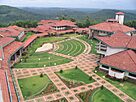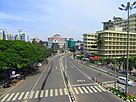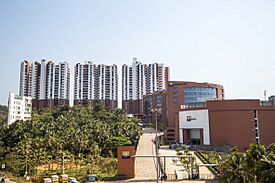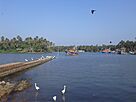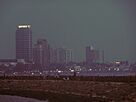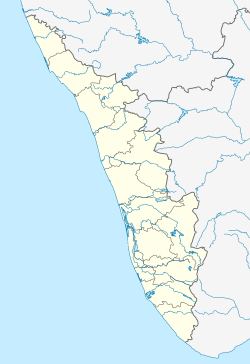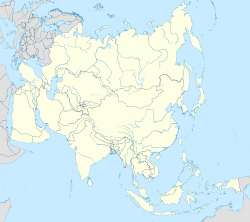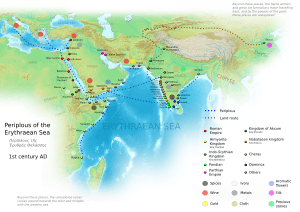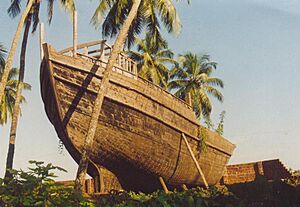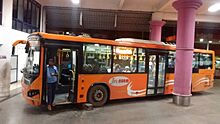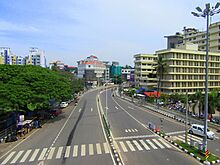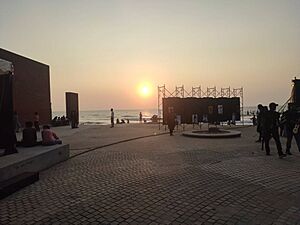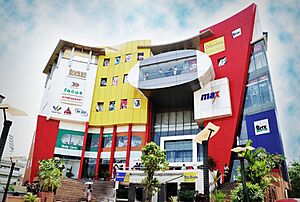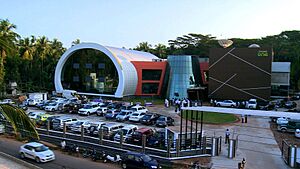Kozhikode facts for kids
Quick facts for kids
Kozhikode
Calicut
|
|
|---|---|
|
From top: Kozhikode Beach, Kakkayam Valley, IIM Kozhikode, Calicut mini bypass, KSRTC bus stand complex, Hilite Mall, Chaliyam harbour, Calicut beach skyline.
|
|
| Nickname(s):
City of Spices (Other nicknames include City of Truth, City of Sculptures, City of Literature, Culinary Capital of Kerala)
|
|
| Country | |
| State | Kerala |
| District | Kozhikode |
| Government | |
| • Type | Municipal corporation |
| Area | |
| • Metropolis | 231 km2 (89 sq mi) |
| • Metro | 518 km2 (200 sq mi) |
| Elevation | 34.47 m (113.09 ft) |
| Population
(2011)
|
|
| • Metropolis | 1,808,056 |
| • Density | 7,827/km2 (20,270/sq mi) |
| • Metro | 3,091,984 |
| Languages | |
| • Official | Malayalam, English |
| Time zone | UTC+5:30 (IST) |
| PIN |
673xxx
|
| Telephone code | +91495xxxxxxx, +91496xxxxxxx |
| Vehicle registration | KL 11, KL 18, KL 56, KL 57, KL 76, KL 77, KL 85, KLD & KLZ (Historical) |
| Sex ratio | 1.093 ♀/♂ |
| Literacy rate | 96.8% |
| International Airport | Calicut International Airport |
Kozhikode (pronounced [koːɻikːoːɖɨ̆]), also known as Calicut until 1990, is a lively city in the state of Kerala, India. It sits along the beautiful Malabar Coast. Kozhikode is famous as the "City of Spices" because of its long history of trading spices. It is also recognized by UNESCO as a "City of Literature."
This city is home to over 600,000 people within its main limits. Its larger metropolitan area has more than 2 million residents. This makes it the second-largest city area in Kerala. The Indian government sees Kozhikode as a "Tier 2" city, meaning it's an important and growing urban center.
Kozhikode was once the capital of an independent kingdom ruled by the Samoothiris (Zamorins). Its port was a major gateway for traders from China, Persia, Arab countries, and Europe. In 2009, a study ranked Kozhikode as the second-best city in India to live in. In 2023, it became India's first City of Literature recognized by UNESCO.
Contents
- What's in a Name? The Story of Kozhikode
- A Glimpse into Kozhikode's Past
- Kozhikode's Weather
- People and Culture: Demographics of Kozhikode
- How Kozhikode is Governed
- Getting Around: Transport in Kozhikode
- Kozhikode's Economy
- Culture and Lifestyle
- Media and Communication
- Learning and Education
- Sports in Kozhikode
- Sister Cities
- Images for kids
- See also
What's in a Name? The Story of Kozhikode
The exact meaning of the name Kozhikode is not fully known. Many people believe it comes from Koyil-kota, which means "fortified palace." Koyil is a local word for a Hindu temple, possibly referring to the Tali Shiva Temple.
The name also changed over time. It became Kolikod, then the Arabic Qāliqūṭ, and finally the English Calicut. Chinese traders called it Kūlifo.
The word "calico" comes from Calicut. This word describes a fine cotton cloth that was sent from Kozhikode to other parts of the world. Even calico cats get their name from this fabric!
A Glimpse into Kozhikode's Past
Long ago, there was an important port called Tyndis near where Kozhikode is today. It was a big trading center between the Chera kingdom and the Roman Empire. Ancient writers like Pliny the Elder mentioned this port.
In the 14th century, Kozhikode grew stronger. It took over parts of central Kerala and became the most powerful kingdom on the Malabar Coast. During this time, martial arts like Kalaripayat were very important. Famous warriors like Aromal Chekavar and his sister Unniyarcha lived here.
Kozhikode's port was the main trading hub in Kerala. Ships from China, known as Ming treasure voyages, visited often in the 15th century.
European Traders Arrive
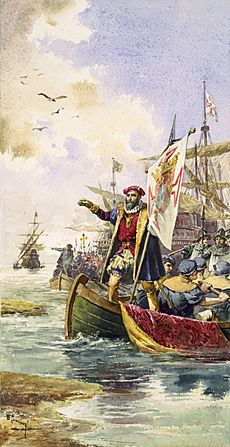
Arab merchants had been trading here since the 7th century. Then, in 1498, the Portuguese explorer Vasco da Gama landed in Kozhikode. This event opened a new sea route between Europe and India. The Portuguese set up a trading post and fort here for a short time.
Later, the English arrived in 1615, followed by the French in 1698, and the Dutch in 1752. In 1765, the Mysore kingdom took control of Kozhikode. The city was once famous for weaving cotton, which is why the fabric "calico" got its name from "Calicut."
Kozhikode Through Travelers' Eyes
Many travelers visited Kozhikode and wrote about what they saw.
- Ibn Battuta (1342–1347): He visited six times and called Kozhikode "one of the great ports of the district of Malabar." He noted that "merchants of all parts of the world are found here." He also mentioned that many Muslim merchants were very wealthy.
- Ma Huan (1403): This Chinese sailor praised Kozhikode as a huge trading center. He saw 20 to 30 mosques for Muslims and noticed how merchants used their fingers and toes to count.
- Abdur Razzak (1442–1443): The Persian ambassador found the harbor very safe. He saw valuable goods from places like Abyssinia and Zanzibar.
- Niccolò de' Conti (1445): This Italian traveler described Kozhikode as full of spices like pepper and cinnamon. He called it an important trading hub for all of India.
- Afanasy Nikitin (1468–1474): This Russian traveler called 'Calecut' a port for the entire Indian sea. He described it as having a "big bazaar."
The Zamorins of Calicut

Kozhikode and its nearby areas were once part of the Polanad kingdom. The Eradis, who wanted access to the sea for trade, fought for 48 years and took control of the area. They then moved their main base to Kozhikode. The city was founded around the 13th century. The ruler became known as the Zamorin.
At their strongest, the Zamorins ruled a large area of Kerala. After Vasco da Gama arrived in 1498, the Portuguese tried to control the seas. The Zamorin's navy, led by the Kunjali Marakkars, fought many battles against the Portuguese. These wars made Kozhikode less important as a trade center. The Kunjali Marakkars are famous for organizing India's first naval defense.
In the early 17th century, the Zamorin, with help from the Dutch East India Company, drove out the Portuguese. The Dutch and Kozhikode signed a treaty in 1604, which was the first treaty the Dutch East India Company made with an Indian ruler.
British Rule in Kozhikode
The British arrived in Kerala in 1615. Kozhikode came under British rule after the Mysore conquered the Malabar Coast in the late 1700s. The British later formed a special army group called the Thiyyar Regiment.
Kozhikode became the capital city of the Malabar District under British rule. This region was important for producing pepper, coconut, tiles, and teak. In 1866, Kozhikode became the first modern municipality in Kerala.
Kozhikode After India's Independence
After India gained independence, Kozhikode Municipality was upgraded to the Kozhikode Municipal Corporation in 1962. This made it the second-oldest Municipal Corporation in the state of Kerala.
Kozhikode's Weather
Kozhikode has a tropical monsoon climate. This means it's generally warm and gets a lot of rain. A short period of "Mango showers" happens in April. The main rainy season, called the South-west monsoon, starts in June and lasts until September. The city also gets rain from the Northeast Monsoon in October and November. The hottest time of year is usually from March to May.
| Climate data for Kozhikode (1991–2020, extremes 1901–2020) | |||||||||||||
|---|---|---|---|---|---|---|---|---|---|---|---|---|---|
| Month | Jan | Feb | Mar | Apr | May | Jun | Jul | Aug | Sep | Oct | Nov | Dec | Year |
| Record high °C (°F) | 36.5 (97.7) |
37.6 (99.7) |
38.6 (101.5) |
39.1 (102.4) |
39.2 (102.6) |
36.2 (97.2) |
35.7 (96.3) |
35.1 (95.2) |
35.7 (96.3) |
36.2 (97.2) |
36.8 (98.2) |
37.0 (98.6) |
39.2 (102.6) |
| Mean maximum °C (°F) | 33.4 (92.1) |
33.7 (92.7) |
34.2 (93.6) |
34.6 (94.3) |
34.5 (94.1) |
32.9 (91.2) |
31.5 (88.7) |
31.1 (88.0) |
31.8 (89.2) |
32.9 (91.2) |
33.2 (91.8) |
33.5 (92.3) |
34.8 (94.6) |
| Mean daily maximum °C (°F) | 32.2 (90.0) |
32.6 (90.7) |
33.2 (91.8) |
33.6 (92.5) |
32.9 (91.2) |
30.0 (86.0) |
29.0 (84.2) |
29.0 (84.2) |
30.2 (86.4) |
31.1 (88.0) |
31.8 (89.2) |
32.2 (90.0) |
31.5 (88.7) |
| Mean daily minimum °C (°F) | 22.8 (73.0) |
23.8 (74.8) |
25.4 (77.7) |
26.4 (79.5) |
26.1 (79.0) |
24.3 (75.7) |
23.7 (74.7) |
23.8 (74.8) |
24.1 (75.4) |
24.2 (75.6) |
24.0 (75.2) |
22.9 (73.2) |
24.3 (75.7) |
| Mean minimum °C (°F) | 20.6 (69.1) |
21.8 (71.2) |
23.5 (74.3) |
23.5 (74.3) |
23.0 (73.4) |
22.5 (72.5) |
22.1 (71.8) |
22.3 (72.1) |
22.8 (73.0) |
22.6 (72.7) |
21.8 (71.2) |
20.5 (68.9) |
20.0 (68.0) |
| Record low °C (°F) | 17.6 (63.7) |
16.1 (61.0) |
19.4 (66.9) |
21.0 (69.8) |
20.0 (68.0) |
20.6 (69.1) |
20.5 (68.9) |
20.6 (69.1) |
21.1 (70.0) |
18.6 (65.5) |
16.1 (61.0) |
16.1 (61.0) |
16.1 (61.0) |
| Average rainfall mm (inches) | 1.6 (0.06) |
4.8 (0.19) |
14.6 (0.57) |
83.5 (3.29) |
223.5 (8.80) |
782.9 (30.82) |
750.0 (29.53) |
432.6 (17.03) |
273.3 (10.76) |
302.6 (11.91) |
120.4 (4.74) |
21.9 (0.86) |
3,011.9 (118.58) |
| Average rainy days | 0.1 | 0.3 | 1.0 | 4.1 | 9.0 | 23.1 | 24.3 | 19.1 | 12.3 | 11.6 | 6.0 | 1.5 | 112.3 |
| Average relative humidity (%) (at 17:30 IST) | 65 | 66 | 69 | 71 | 75 | 85 | 87 | 86 | 82 | 78 | 73 | 65 | 75 |
| Source: India Meteorological Department | |||||||||||||
People and Culture: Demographics of Kozhikode
Religion in Kozhikode City (2011) Hinduism (57.37%) Islam (37.66%) Christianity (4.60%) Other (0.37%)
Kozhikode is a city with many different groups of people and religions. Hindus are the largest group, followed by Muslims and Christians. The city has a high literacy rate of 96.8%, which is much higher than the national average. This means most people in Kozhikode can read and write.
Historically, Kozhikode was home to many communities. These groups often kept their traditional jobs and customs. For example, Brahmins lived near Hindu temples. Other groups like Tamil Brahmins, Gujaratis, and Marwari Jains also settled in the city.
The Muslims in Kozhikode are called Mappilas. Many of them follow the Sunni branch of Islam. Some Muslims in the older parts of the city follow a special family system where property is passed down through the mother's side.
While Christianity has been in Kerala for a very long time, the Christian community in northern Kerala grew more after Portuguese missionaries arrived in the late 1400s.
How Kozhikode is Governed
The city of Kozhikode is managed by the Kozhikode Corporation. It is led by a Mayor. The city is divided into 75 areas called wards. People in these wards elect members to the corporation council every five years. Some nearby areas like Beypore and Elathur have recently joined the municipal corporation.
| Kozhikode Municipal Corporation | |
|---|---|
| Mayor | Beena Philip |
| Deputy Mayor | Musafar Ahmed |
| Member of Parliament | M.K.Raghvan |
| District Collector | Shri. Narasimhugari T L Reddy IAS |
| Police Commissioner | Shri Rajpal Meena IPS |
The Kozhikode Corporation was the first city corporation in Kerala when the state was formed in 1962. Its first mayor was H Manjunatha Rao. Kozhikode has four areas for state assembly elections: Kozhikode North, Kozhikode South, Beypore, and Elathur. All of these are part of the larger Kozhikode area for national elections.
Kozhikode Municipal Corporation Election 2020 Results
Here's how the different political parties performed in the 2020 local elections:
| S.No. | Party Name | Party symbol | Number of Corporators |
|---|---|---|---|
| 01 | LDF | 49 | |
| 02 | UDF | 14 | |
| 03 | BJP | 07 | |
| 04 | Independents | 05 |
Keeping the Peace: Law and Order
The Kozhikode City Police is in charge of keeping law and order. It is led by a commissioner, who is a senior police officer. The city police has 16 police stations and works under the Home Ministry of the Government of Kerala.
Getting Around: Transport in Kozhikode
Roads and Highways
Kozhikode is well-connected by national highways.
- National Highway 66 runs along the west coast. It connects Kozhikode to major cities like Mumbai in the north and Kochi and Kanyakumari in the south.
- National Highway 766 links Kozhikode to Bangalore in Karnataka. It passes through beautiful places like Sulthan Bathery and Kalpetta.
- National Highway 966 connects Kozhikode to Palakkad. This highway also leads to the Calicut International Airport.
Several state highways also pass through Kozhikode, connecting it to other towns and regions within Kerala.
Bus Services
Buses are a popular way to travel in Kozhikode. City buses are painted green. The Kerala State Road Transport Corporation (KSRTC) runs buses to many places in Kerala and neighboring states.
Kozhikode has three main bus stands:
- The Palayam Bus Stand is for private buses going to nearby towns.
- The Mofussil Bus Stand is for private buses going to other districts.
- The KSRTC Bus Stand is for KSRTC buses. It's the largest bus stand in Kerala!
You can also find luxury bus services run by private companies. These buses offer comfortable night journeys to cities like Mumbai, Bangalore, and Chennai.
Rail Travel
Kozhikode has a main railway station where all long-distance trains stop. There are also smaller stations within the city limits. You can travel to almost any part of India by train from Kozhikode. The first railway tracks in Kerala were laid near Kozhikode in 1861.
Air Travel
The Calicut International Airport is about 26 km from the city. It's located in Karipur, in the Malappuram district. The airport started in 1988 and became an international airport in 2006. It has flights to major Indian cities and other countries.
Kozhikode's Economy
Kozhikode is a big economic center in Kerala. The service industry, like IT and tourism, is very important here. The city is growing in the technology sector. Cyberpark, a government organization, is building IT parks to create jobs in the Malabar region. These parks are expected to create many direct job opportunities.
Kozhikode was named the "City of Sculptures" (Shilpa Nagaram) in 2012. This is because of the many beautiful sculptures found around the city.
Culture and Lifestyle
Shopping in Kozhikode
Kozhikode has always been a city of trade. The main shopping area used to be Valiyangadi (Big Bazaar). Now, the heart of shopping is Mittai Theruvu, also known as Sweetmeat Street. This long street is packed with shops selling everything from traditional saris to cosmetics. You can also find many restaurants and sweet shops here.
Today, Kozhikode has many modern shopping malls. Some popular ones include Focus Mall, HiLITE Mall, and Gokulam Mall. A new Lulu Mall has also opened in Mankavu.
Music Scene
Kozhikode loves music! Besides the Malabar Mahotsavam, which is an annual cultural festival, there's a five-day music festival every year. It honors the famous composer Tyagaraja. The festival includes traditional music performances by both professionals and students.
Kozhikode also has a special love for Ghazal and Hindustani music. The late film director and singer M. S. Baburaj, who was from Kozhikode, was greatly inspired by these music styles.
Media and Communication
Newspapers
Newspapers have a long history in Kozhikode. The first English weekly, West Coast Spectator, started here in 1879. The first Malayalam newspaper, Kerala Pathrika, began in 1884. Many important newspapers that supported India's independence movement, like Mathrubhumi, were based in Kozhikode. Today, almost all major Malayalam and English newspapers have editions in the city.
Radio Stations
Kozhikode has a radio station from All India Radio with both AM and FM channels. There are also several private FM radio stations like Radio Mango 91.9, Radio Mirchi, Club FM 104.8, and Red FM 93.5.
Television Channels
A television transmitter has been working in Kozhikode since 1984. It relays programs from Delhi and Thiruvananthapuram Doordarshan. Several Malayalam TV channels, such as Shalom Television, Darshana TV, and Media One TV, have their main offices or news bureaus in Kozhikode. All major Malayalam channels also have studios and news teams in the city.
You can also get satellite television services from various providers. Local cable operators like ACV and Spidernet offer daily city news.
Learning and Education
Kozhikode district has many schools, including 191 high schools.
The city is home to two very important national educational institutions:
- The Indian Institute of Management Kozhikode (IIMK)
- The National Institute of Technology Calicut (NITC)
Other research centers in Kozhikode include the Indian Institute of Spices Research (IISR).
The University of Calicut is the largest university in Kerala. It is located about 24 km south of Kozhikode. Many colleges in the region are connected to this university. The Calicut Medical College, established in 1957, is now the largest medical institute in Kerala.
The Government Law College, Kozhikode is owned by the Kerala government. It helps students in the northern part of Kerala study law.
Some other important colleges in Kozhikode city are Zamurians Guruvayoorappan College, Malabar Christian College, Farook College, and Devagiri College.
Sports in Kozhikode
Football
Kozhikode is a big fan of football! It is home to the I-League club Gokulam Kerala. This team has won two titles and the Durand Cup.
Volleyball
The city also has a professional volleyball team called Calicut Heroes. They play in the top league, the Prime Volleyball League.
Sister Cities
Kozhikode has a sister city:
Images for kids
See also
 In Spanish: Kozhikode para niños
In Spanish: Kozhikode para niños




